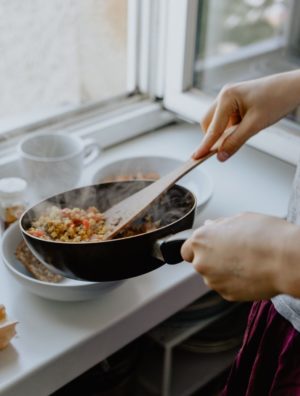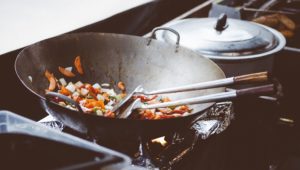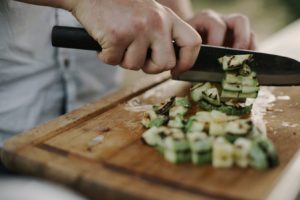Contents

While there are literally dozens of other cooking techniques available, you need to nail down these ten. Once you build your skill level with these techniques, you could pretty much tackle any kind of recipe.
That’s right-as diverse as the world’s cuisines maybe if you learn how to cook using these ten (10) techniques, you could pretty much handle almost all available recipes on the internet regardless of where they come from.
1. Broiling
When you broil something, you cook it by exposing it directly to radiant heat. Either you put it on a grill, which is fed by live coals or an open flame, or it’s heated by the electric coil.
Regardless, when you broil you cook something through direct heat. The heat radiates out from the source and it slowly or quickly cooks the item that you’re exposing to it.
2. Stir-frying
A long time ago, Chinese cooks had a problem on their hands. They need to cook food but they didn’t have much fuel. So, what they needed is a cooking method that maximizes the small amount of fuel that they have.
Accordingly, they wanted to cook items very quickly with as little fuel as possible. This is where stir-frying began.
Using a special pan called the “wok” that exposes only a small part of its underside to the direct flame, Chinese cooks could quickly prepare large dishes by exposing food ingredients to that heated part of the oiled wok while stirring the ingredients. With enough heat and a lot of elbow crease and speed, you can go through a tremendous amount of ingredients in no time.
3. Baking
When you bake something, you use dry heat. You don’t expose the food to the heat directly. You use ambient heat that is generated by hot stones, ashes or some sort of coal. The most common item that’s baked is, of course, bread. But there are all sorts of ingredients that you can use with this cooking technique.
4. Roasting
Roasting involves creating hot air through the use of dry heat. The air envelopes the food while the heat reaches the food directly. This produces uneven heat.
You can use an open flame. You can use an oven-based heat system or other more complicated heat sources. The bottom line is, there is a minimum temperature involved. You’re roasting when you are using at least 150 centigrade of heat.
5. Grilling
Grilling involves the direct application of dry heat to the food surface. This usually comes from either from the side, from the top or from the bottom of the food.
This requires a tremendously high amount of radiant heat. The plus side of this technique is that it cooks vegetables and meat very quickly. The downside is, it’s very easy to burn your food if you’re not paying attention.
 6. Sautéing
6. Sautéing
Sautéing involves oil. You put oil on a shallow pan and heat it up. Once the oil starts to smoke or starts to bubble, you add the ingredients that you want to sauté.
You don’t necessarily have to stir very quickly. Sautéing refers more to the oil that is applied to the pan over a very high level of heat. And also, it covers a larger area than stir-frying.
7. Searing
Searing actually applies to sautéing, roasting, braising, baking and grilling. It’s kind of a sub-technique.
Regardless of the main technique that you’re using, let’s say baking when you sear something the surface of the main dish that you’re cooking creates a crust. It looks brown or light brown, but that you apply enough heat to create that crust and then you take out the item that you’re cooking.
8. Braising
This is a combination technique. You use both dry and wet heat. The food is first seared or sautéed at a very high temperature. Then you cover the pot and then you put liquid around the food and you lower the temperature.
Braising is great because it combines the benefits of searing with the slow-cooked goodness of liquid-based boiling.
9. Steaming
When you steam a food item, you basically expose it to the steam being produced by boiling water. Many Chinese dishes, like Dim Sum, are specially formulated to tap the power of steaming.
You cook food indirectly with this technique. You don’t apply the direct heat to the surface of the food. Instead, the heated water vapors and do the cooking.
The great thing about steaming is that it actually triggers an internal percolation effect in the ingredient that’s being cooked. Most food ingredients have a certain degree of moisture.
So when you steam an item, it actually triggers internal cooking of the water content of the ingredients that you are steaming. It is also great for buns and any other flour-based dishes like Chinese dumplings.
10. Stewing
Stewing involves boiling and a certain degree of sautéing. Generally speaking, when you stew something, you would take the ingredient, primarily meat or some tough vegetables, and you sauté them first or apply some heat on them with some oil.
And then, you add water to eventually boil or simmer at a very low heat over a long period of time. The result is slow-cooked food. Regardless of how tough the ingredients originally started out, if you stew them right with the right seasonings, you can soften them eventually.
Here’s a video that could add a few more techniques to your cooking skills arsenal:
 6. Sautéing
6. Sautéing